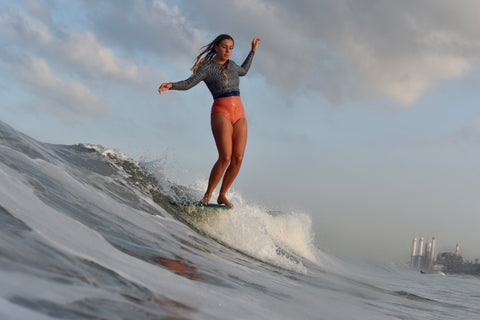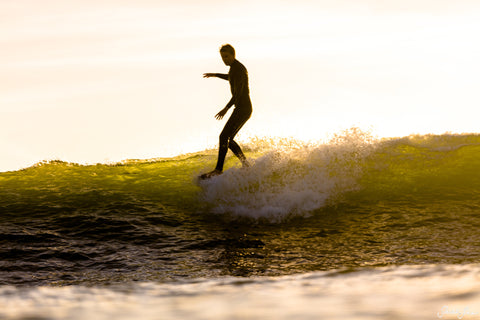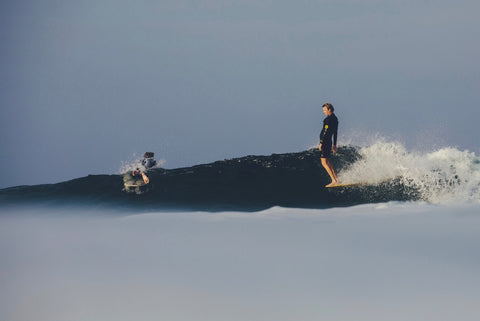
Longboarders. Those silky-smooth water dancers bouncing along their board with the grace of a doused ballerina. You love to watch them glide across waves and step up to the nose, levitating in the curl like they’re freaking Jesus walking on water.
You’ve studied them. You’ve watched every youtube video out there and maybe stalked at few at your local spot. You’ve practiced for unmentionable hours and have almost gotten it down. So with grandiose enthusiasm, you paddle out on your traditional single-fin, slide down a gentle peeler, pop up with volition and start to step down your board. Which is now starting to feel a bit wobbly. Balance is starting to fade from existence. But you muster up some grit and take that last and final step to the nose - and instead you step right off your board into a face and mouthful of water, eyes stinging from your awkward, belly-flop impact.
So why the heck is this noseriding business so damn hard and why does it take a lifetime to master? It doesn’t. Let’s start with a clean slate. Wipe out all your knowledge of noseriding, read a few simple tips, and be on your way to glidin', slidin' heaven.
1. Choose the Right Equipment
Light, squirrely longboards are geared toward performance surfing, with heavy emphasis on hard turns and fast maneuvers. Heavy, traditional, long singlefins are geared toward the art of noseriding, and provide a more stable surface on the nose. The right length is just as important as the right type of board, with different lengths varying between each surfer due to height and weight. A magic number seen across most sizes and shapes of noseriding professionals is 9'6. A big, clunky fin will give you some added stability.

2. Take the High Line
Setting up in the correct part of the wave is crucial. If you have tried to hang five or hang ten before and instead your board and you sink to a watery depression, you may be aiming to ride the nose on a flatter part of the wave. A good noseriding wave produces a fast, peeling, moderately steep slope in which you can levitate. After your bottom turn, set your line high on the wave, and stay with the critical section - the section nearest to the whitewater. Some keen advice I've received went like this: "When you find yourself in the OH SHIT part of the wave, that's where you'll do your best noseriding." Stay high and tight, in the critical section of the wave.
Watch below as Christian Stutzman demonstrates proper section stance on the wave, with a 36 second noseride at Malibu near the end.
3. Stand Tall
In noseriding, posture is everything. The main difficulty beginning gliders have when starting out is their tendency to crouch down, with a quite pronounced butt, trying to get to the front of the board with an awkwardly convoluted body. The best advice you can possibly get, well-demonstrated and observed, is to stand tall. Pretend like you have a board in your spine and you cannot bend past your front knee. Carry yourself with ballerina-like dignity, chest pronounced, with most of your weight shifted to your back foot for added balance.
A shift in weight and posture will surely improve your noseriding capabilities immensely.

4. Embrace the Cross-Step
Shuffling your feet is the woe of the longboard world. To adequately complete a proper noseride, a beginning longboarder should embrace the practice of the cross step. Start slowly, making a small movements forward and back, then graduating on to longer steps down the board. Keep your weight back - falling forward is typical in learning how to cross-step, so keep that weight behind your front foot. Also, enlist in a calf-leash to avoid tripping over the annoying cord, or ditch the leash altogether in a safe place where you can properly learn to control your surfboard (by safe, we mean not littered with people that you could potentially hit with a heavy board by losing it.)
5. Count Your Steps
Miscalculation of where the end of the nose is, as well as how many steps it takes to get there is common in the world of longboarding. With your equipment, measure the length of your stride by placing your board on the sand, and jump on to see where you generally stand on it. In general, you can usually either take one large, leap-like cross-step, or two smaller ones to get to the end of the nose. The goal, at least for hanging five, is to curl your toes around the end of the board, where they are slightly hanging off. See what your steps feel like and keep repeating until muscle memory has the end of your front foot dangling off the end of the board with comfort.

6. Arms Down
Many people think raised arms increase balance, but in the noseriding world, it is the opposite. If you're trying to hang five or hang ten, your arms can just throw you off. Try to keep your arms below your heart, and instead keep your core strong. To aid in balance, shift your back arm up and down rather than your front.
Hopefully this will get you on your way to longboard levitating! Good luck and comment below on your progress!
As always, contact us for any comments, questions, or just to say what's up.


